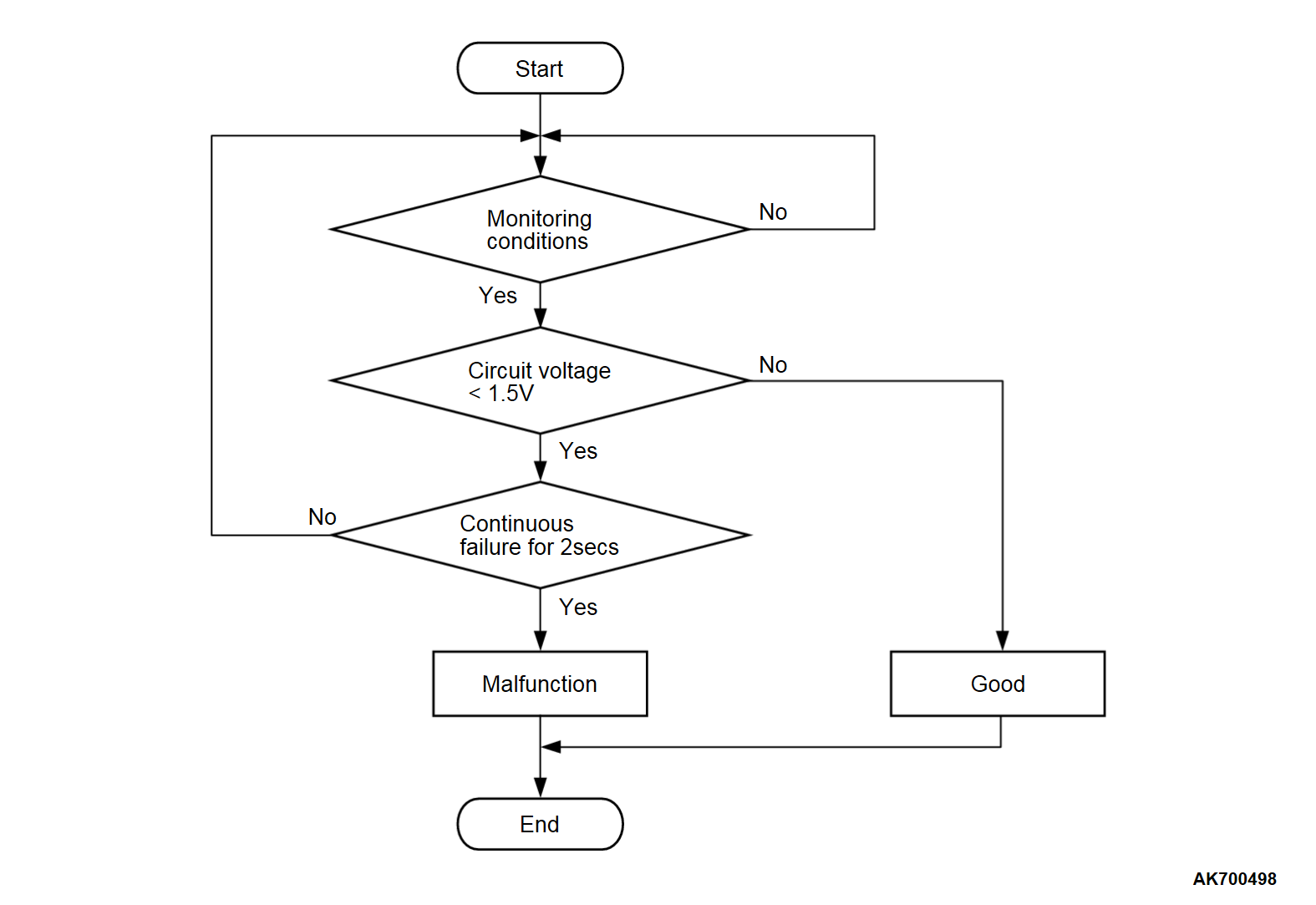DTC P001A: Camshaft Profile Control (Oil Feeder Control Valve) Circuit
CIRCUIT OPERATION
- The oil feeder control valve power is supplied from the MFI relay.
- The ECM controls ground oil feeder control valve by turning the power transistor in the ECM "ON" and "OFF".
TECHNICAL DESCRIPTION
- The engine oil pressure switches the cams to operate the MIVEC system in the low-speed or high-speed mode in accordance with the signals from the ECM.
DESCRIPTIONS OF MONITOR METHODS
- Circuit voltage stays low when solenoid status is off.
MONITOR EXECUTION
- Continuous
MONITOR EXECUTION CONDITIONS (Other monitor and Sensor)
Other Monitor (There is no temporary DTC stored in memory for the item monitored below)
- Not applicable
Sensor (The sensor below is determined to be normal)
- Camshaft position sensor
- Mass airflow sensor
- Engine coolant temperature sensor
- Throttle position sensor
- Injection valve
Check Conditions
- Ignition switch: "ON"
- Oil feeder control valve is OFF.
- Battery positive voltage is between10 and 16.5 volts.
- 0.1 seconds has elapsed after the above mentioned conditions have been met.
Judgment Criterion
- The ECM terminal voltage of oil feeder control valve circuit is less than 1.5 volts for 2 seconds.
FAIL-SAFE AND BACKUP FUNCTION
- Does not switch to high-speed cam.
TROUBLESHOOTING HINTS (The most likely causes for this code to be stored are: )
- Connector damage.
- Harness damage.
- Oil feeder control valve failed.
- ECM failed.
DIAGNOSIS
Required Special Tools:
- MB992744: Vehicle communication interface-Lite (V.C.I.-Lite)
- MB992745: V.C.I.-Lite main harness A
- MB992747: V.C.I.-Lite USB cable short
- MB992748: V.C.I.-Lite USB cable long
- MB991958: Scan Tool (M.U.T.-III Sub Assembly)
- MB991824: Vehicles Communication Interface (V.C.I.)
- MB991827: M.U.T.-III USB Cable
- MB991910: M.U.T.-III Main Harness A (Vehicles with CAN communication system)
- MB992110: Power Plant ECU Check Harness
STEP 1. Using scan tool (M.U.T.-III), check actuator test item 17: Oil Feeder Control Valve.
| caution | To prevent damage to scan tool (M.U.T.-III), always turn the ignition switch to the "LOCK" (OFF) position before connecting or disconnecting scan tool (M.U.T.-III). |
(2) Turn the ignition switch to the "ON" position.
(3) Set scan tool (M.U.T.-III) to the actuator test mode for item 17, Oil Feeder Control Valve.
- An operation sound should be heard and vibration should be felt when the oil feeder control valve is operated.
(4) Turn the ignition switch to the "LOCK" (OFF) position.
Is the actuator operating properly?
STEP 2. Check the oil feeder control valve.
(1) Disconnect the oil feeder control valve connector and measure at oil feeder control valve side.
(2) Measure the resistance between oil feeder control valve side connector terminals.
Standard value: 6.9 - 7.9 ohms [at 20°C (68°F)]
Is the measured resistance between 6.9 and 7.9 ohms [at 20°C (68°F)]?
STEP 3. Measure the power supply voltage at oil feeder control valve harness side connector.
(1) Disconnect the oil feeder control valve connector and measure at the harness side.
(2) Turn the ignition switch to the "ON" position.
(3) Measure the voltage between terminal power supply line and ground.
- Voltage should be battery positive voltage.
(4) Turn the ignition switch to the "LOCK" (OFF) position.
Is battery positive voltage (approximately 12 volts) present?
STEP 4. Measure the power supply voltage at ECM connector by using power plant ECU check harness special tool MB992110.
(1) Disconnect all ECM connectors. Connect the power plant ECU check harness special tool MB992110 between the separated connectors.
(2) Turn the ignition switch to the "ON" position.
(3) Measure the voltage between terminal OCV and ground.
- Voltage should be battery positive voltage.
(4) Turn the ignition switch to the "LOCK" (OFF) position.
Is battery positive voltage (approximately 12 volts) present?
STEP 5. Check of harness damage in power supply line between MFI relay connector and oil feeder control valve connector.
Is the harness wire in good condition?
STEP 6. Check of harness damage in OCV line between oil feeder control valve connector and ECM connector.
Is the harness wire in good condition?
STEP 7. Using scan tool (M.U.T.-III), check actuator test item 17: Oil Feeder Control Valve.
(1) Turn the ignition switch to the "ON" position.
(2) Set scan tool (M.U.T.-III) to the actuator test mode for item 17, Oil Feeder Control Valve.
- An operation sound should be heard and vibration should be felt when the oil feeder control valve is operated.
(3) Turn the ignition switch to the "LOCK" (OFF) position.
Is the actuator operating properly?
![[Previous]](../../../buttons/fprev.png)
![[Next]](../../../buttons/fnext.png)



